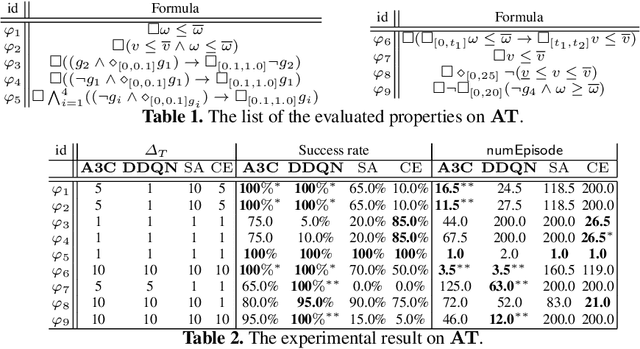Yoriyuki Yamagata
Falsification of Cyber-Physical Systems Using Deep Reinforcement Learning
May 01, 2018

Abstract:With the rapid development of software and distributed computing, Cyber-Physical Systems (CPS) are widely adopted in many application areas, e.g., smart grid, autonomous automobile. It is difficult to detect defects in CPS models due to the complexities involved in the software and physical systems. To find defects in CPS models efficiently, robustness guided falsification of CPS is introduced. Existing methods use several optimization techniques to generate counterexamples, which falsify the given properties of a CPS. However those methods may require a large number of simulation runs to find the counterexample and is far from practical. In this work, we explore state-of-the-art Deep Reinforcement Learning (DRL) techniques to reduce the number of simulation runs required to find such counterexamples. We report our method and the preliminary evaluation results.
* 9 pages, 1 figure, to be presented at FM2018
Anomaly Detection for a Water Treatment System Using Unsupervised Machine Learning
Sep 25, 2017



Abstract:In this paper, we propose and evaluate the application of unsupervised machine learning to anomaly detection for a Cyber-Physical System (CPS). We compare two methods: Deep Neural Networks (DNN) adapted to time series data generated by a CPS, and one-class Support Vector Machines (SVM). These methods are evaluated against data from the Secure Water Treatment (SWaT) testbed, a scaled-down but fully operational raw water purification plant. For both methods, we first train detectors using a log generated by SWaT operating under normal conditions. Then, we evaluate the performance of both methods using a log generated by SWaT operating under 36 different attack scenarios. We find that our DNN generates fewer false positives than our one-class SVM while our SVM detects slightly more anomalies. Overall, our DNN has a slightly better F measure than our SVM. We discuss the characteristics of the DNN and one-class SVM used in this experiment, and compare the advantages and disadvantages of the two methods.
 Add to Chrome
Add to Chrome Add to Firefox
Add to Firefox Add to Edge
Add to Edge